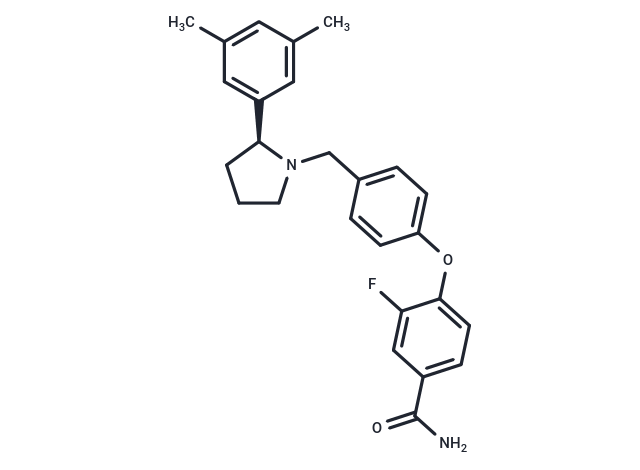Shopping Cart
- Remove All
 Your shopping cart is currently empty
Your shopping cart is currently empty

Aticaprant (CERC-501) is a potent and centrally-penetrant antagonist of the kappa-opioid receptor (Ki: 0.807 nM).[2]

| Pack Size | Price | Availability | Quantity |
|---|---|---|---|
| 1 mg | $34 | In Stock | |
| 2 mg | $48 | In Stock | |
| 5 mg | $80 | In Stock | |
| 10 mg | $128 | In Stock | |
| 25 mg | $272 | In Stock | |
| 50 mg | $428 | In Stock | |
| 100 mg | $639 | In Stock | |
| 1 mL x 10 mM (in DMSO) | $89 | In Stock |
| Description | Aticaprant (CERC-501) is a potent and centrally-penetrant antagonist of the kappa-opioid receptor (Ki: 0.807 nM).[2] |
| Targets&IC50 | κ opioid:0.807 nM (Ki) |
| In vitro | Aticaprant(CERC-501) binds with a high affinity to the human kappa opioid receptor with a 30-fold higher affinity over the human mu-opioid receptor and a 190-fold higher affinity over the human delta-opioid receptor. Aticaprant(CERC-501) shows no appreciable affinity for several non-opioid cell surface G-protein-coupled receptor targets [1]. |
| In vivo | METHODS: Mice were given Aticaprant(CERC-501) (0.1 to 3 mg/kg, intraperitoneal injection) 30 minutes before the alcohol deprivation effect (ADE) test and naltrexone (0.3 or 1 mg/kg, intraperitoneal injection) 10 minutes before the test to observe the effect of aticaprant on the ADE effect. RESULTS 0.3 mg/kg of Aticaprant(CERC-501) and 1 mg/kg of naltrexone reduced the ADE alcohol intake of mice at 4 hours. [1] |
| Animal Research | Three male cannulated rats are administered a single 1 mg/kg intravenous (IV) and 10 mg/kg oral (PO) dose of Aticaprant to determine the pharmacokinetic parameters. Plasma samples are collected at 0.08 (IV only), 0.25, 0.5, 1, 2, 4, 8, 12 and 24 h post-dose and analyzed by liquid chromatography coupled to tandem mass spectral detection to determine the concentrations of Aticaprant (CERC-501). Male mice are administered a single 10 mg/kg PO dose of Aticaprant to determine the pharmacokinetic parameters. Plasma samples are collected at 0.5, 1, 2, 4, 8, and 24 h post-dose and analyzed by LCMS/MS to determine the concentrations of Aticaprant. The plasma and brain binding of Aticaprant is determined by equilibrium dialysis at 1 μM [1]. |
| Alias | LY-2456302, CERC-501 |
| Molecular Weight | 418.5 |
| Formula | C26H27FN2O2 |
| Cas No. | 1174130-61-0 |
| Smiles | Cc1cc(C)cc(c1)[C@@H]1CCCN1Cc1ccc(Oc2ccc(cc2F)C(N)=O)cc1 |
| Relative Density. | 1.201 g/cm3 (Predicted) |
| Storage | Powder: -20°C for 3 years | In solvent: -80°C for 1 year | Shipping with blue ice. | |||||||||||||||||||||||||||||||||||
| Solubility Information | DMSO: 100 mg/mL (238.95 mM), Sonication is recommended. | |||||||||||||||||||||||||||||||||||
Solution Preparation Table | ||||||||||||||||||||||||||||||||||||
DMSO
| ||||||||||||||||||||||||||||||||||||

Copyright © 2015-2025 TargetMol Chemicals Inc. All Rights Reserved.